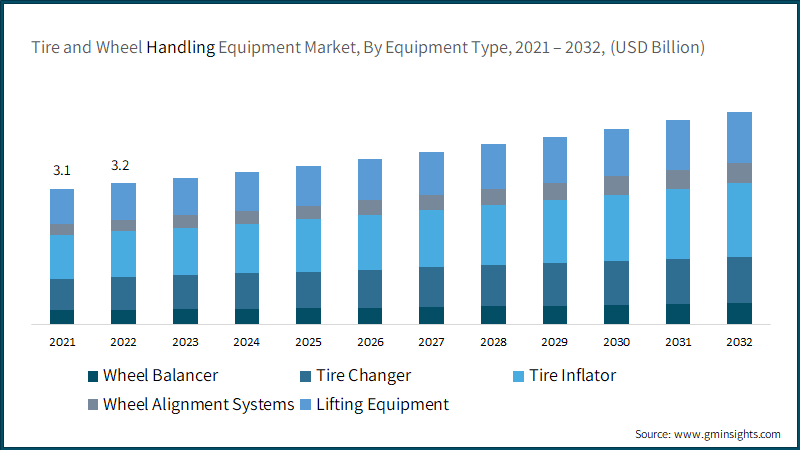Home > Automotive > Aftermarket > Maintenance and Service > Tire and Wheel Handling Equipment Market
Tire and Wheel Handling Equipment Market Analysis
- Report ID: GMI7230
- Published Date: Oct 2023
- Report Format: PDF
Tire and Wheel Handling Equipment Market Analysis
Based on equipment type, the tire and wheel handling equipment industry is categorized into wheel balancer, tire changer, tire inflator, wheel alignment systems, and lifting equipment. The wheel alignment systems segment will expand at a high CAGR from 2023 to 2032. The automotive industry's advancements including the emergence of electric and autonomous vehicles, necessitate highly precise wheel alignment systems. These specialized vehicles require meticulous alignment to optimize their performance, safety, and energy efficiency, fueling the advanced wheel alignment equipment demand. Safety concerns also play a significant role in the growing popularity of wheel alignment systems. Proper wheel alignment is vital for road safety as misaligned wheels can result in uneven tire wear, compromised handling stability, and increased braking distances. The heightened focus on safety pushes automotive service centers to invest in advanced wheel alignment equipment to ensure that vehicles are in peak condition.

Based on end-user, the market is segmented into repair shops, tire service centers, motorcycle repair shops and OEM dealerships. In this highly competitive industry, dealerships have majority of the market share, 31% as they have a deep & direct connection with vehicle manufacturers and receive the latest equipment recommendations & specifications, which allows them to stay at the forefront of industry advancements. This positions dealers as early adopters of cutting-edge tire and wheel handling equipment, ensuring they can provide the most advanced and specialized services to customers. Dealerships operate as one-stop shops for vehicle sales, service, and maintenance, which makes them the primary hubs for tire and wheel servicing. They have a steady & reliable stream of customers who rely on their expertise and equipment for maintenance & repairs.

North America tire and wheel handling equipment industry is witnessing robust growth due to high concentration of vehicle manufacturers, automotive service centers, and dealerships. The high concentration generates a substantial demand for tire and wheel handling equipment, as the industry requires advanced machinery for vehicle servicing and maintenance. The automotive culture in the region, characterized by a strong emphasis on personal vehicles and long-distance travel, leads to a high demand for tire services and equipment.

